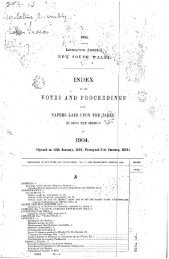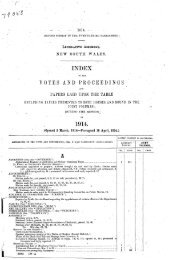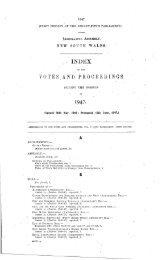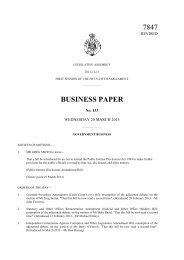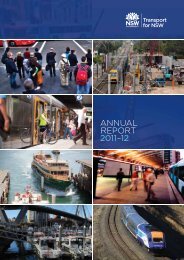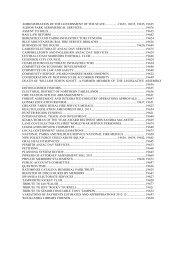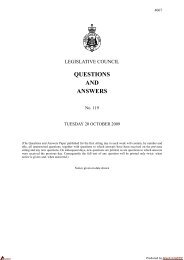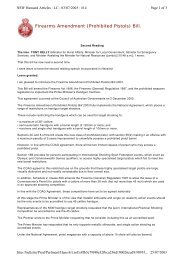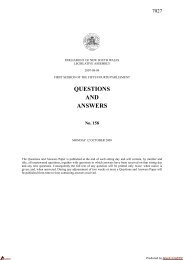Endeavour Energy Annual Performance Report - Parliament of New ...
Endeavour Energy Annual Performance Report - Parliament of New ...
Endeavour Energy Annual Performance Report - Parliament of New ...
Create successful ePaper yourself
Turn your PDF publications into a flip-book with our unique Google optimized e-Paper software.
09<br />
Financial<br />
statements<br />
Notes to the Financial Statements<br />
For the year ended 30 June 2011<br />
21 Financial Instruments continued<br />
The following table summarises the impact <strong>of</strong> changes in commodity prices on the Corporation’s post-tax pr<strong>of</strong>it<br />
and equity. For the 2010 financial year, a 6% movement in electricity prices was applied to the forward electricity<br />
curve. All variables other than the electricity price were held constant in the summary below. For the 2011 financial<br />
year, variability in electricity prices does not impact <strong>Endeavour</strong> <strong>Energy</strong>’s cash flows, and a nil impact has therefore<br />
been disclosed.<br />
Price risk – impact <strong>of</strong> changes in electricity prices<br />
2011 2010<br />
Pr<strong>of</strong>it or loss<br />
$’000<br />
Equity<br />
$’000<br />
Pr<strong>of</strong>it or loss<br />
$’000<br />
Equity<br />
$’000<br />
6% increase in electricity price – – 8,097 28,634<br />
6% decrease in electricity price – – (8,893) (28,634)<br />
(ii) Commodity price risk<br />
Price risk is the risk that <strong>Endeavour</strong> <strong>Energy</strong>’s cash flows will be adversely affected by movements in commodity prices<br />
that increase the Australian dollar value <strong>of</strong> commodity payables. <strong>Endeavour</strong> <strong>Energy</strong> is exposed to price risk through<br />
the purchase <strong>of</strong> goods for the capital asset program.<br />
Regular reports are submitted to the <strong>Endeavour</strong> <strong>Energy</strong> Board, detailing hedging positions undertaken for commodity<br />
price risk, including volume and mark to market valuations <strong>of</strong> hedging undertaken.<br />
The following table summarises the impact <strong>of</strong> changes in commodity prices on the Corporation’s post-tax pr<strong>of</strong>it and<br />
equity. A 5% movement in commodity prices has been applied to the forward commodity curve as at balance date.<br />
All variables other than the commodity price are held constant in the summary below.<br />
Price risk – impact <strong>of</strong> changes in commodity prices<br />
2011 2010<br />
Pr<strong>of</strong>it or loss<br />
$’000<br />
Equity<br />
$’000<br />
Pr<strong>of</strong>it or loss<br />
$’000<br />
Equity<br />
$’000<br />
5% increase in commodity price 940 – – –<br />
5% decrease in commodity price (940) – – –<br />
Sensitivity to reasonably possible price movements in the above table reflects <strong>Endeavour</strong> <strong>Energy</strong>’s use <strong>of</strong> commodity<br />
derivatives within a portfolio to manage risk. As the designation is “fair value through pr<strong>of</strong>it and loss” the movement<br />
in equity is nil.<br />
(d) Interest rate risk<br />
Interest rate risk is the risk <strong>of</strong> a reduction in earnings and/or the net present value <strong>of</strong> the Corporation as a consequence<br />
<strong>of</strong> adverse movements in interest rates. Interest rate risk is managed by the Treasury function within <strong>Endeavour</strong> <strong>Energy</strong>.<br />
The Corporation’s exposure to market risk for changes in interest rates relates primarily to interest bearing liabilities<br />
as <strong>Endeavour</strong> <strong>Energy</strong> borrows funds at both fixed and floating interest rates. The Corporation’s policy is to manage its<br />
interest cost using a mix <strong>of</strong> fixed and variable rate debt, and by the use <strong>of</strong> interest rate derivatives. Hedging activities<br />
are evaluated regularly to align with interest rate views and defined risk appetite, ensuring optimal strategies are<br />
applied by either positioning the Statement <strong>of</strong> Financial Position or protecting interest expense through different<br />
interest rate cycles.<br />
82



